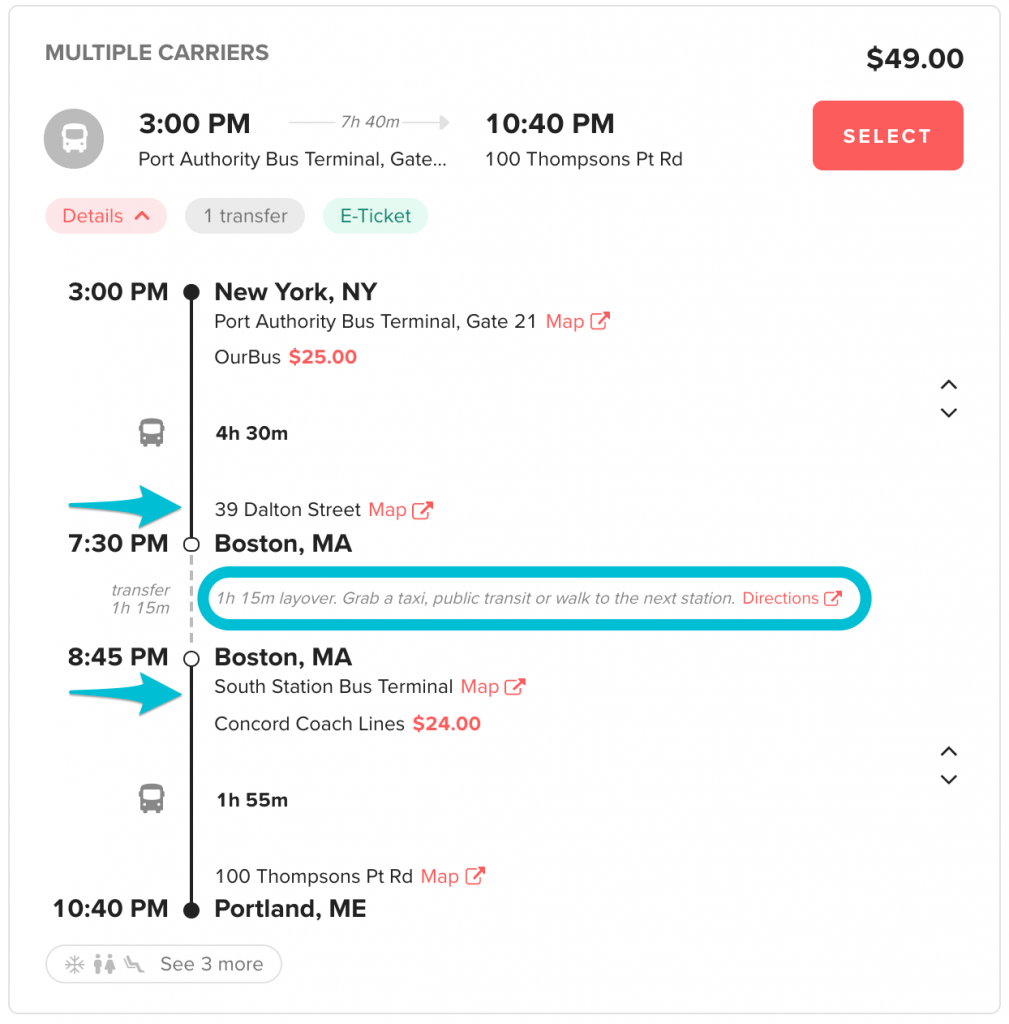Table of Contents
Bus routes connect more than 2,000 cities in the United States alone.
While thousands and thousands of routes between these cities are direct, you can reach even more destinations when you book a bus trip with a transfer.
A bus journey with a transfer has more than one part (or “leg”). The first leg is on the bus you board at the departure station. At some point during your journey, this bus will arrive at the transfer station, where you will deboard and get on a different bus headed to your destination.
And since Wanderu is your one-stop-shop for bus travel, you can book both of these legs at once. We even stitch together routes from different bus companies to offer you routes with transfers that you can’t book anywhere else.
This guide will equip you with everything you need to know for a stress-free transfer from one bus to another. Then, it’s your turn to discover how far you can go by bus.
What is a transfer?
In bus travel, a transfer refers to the change from one bus to another. Much like a layover between flights, you get off the bus, walk to the next boarding gate or station, and board a new bus.
Transfers are necessary because buses do not travel directly between every single city. For example, there is no direct bus route from Dallas to New Orleans. This would be a bummer for your Mardi Gras plans, if not for a transfer in Houston.
Direct buses run from Dallas to Houston and from Houston to New Orleans. So you can book a ticket on each of these routes and transfer from the first bus to the second bus in Houston.
How do I know if my trip has a transfer?
In Wanderu’s search results, the number of transfers in each trip appears in gray. A trip with “0 transfers” provides direct service from the first city to the second city, so you’ll be able to stay on the same bus for the whole trip.

You can click the red Details drop-down on any trip to view the full itinerary, including transfer information.
If you prefer to stay on the same bus for the whole ride, you can always filter out any trips with transfers in the results. When searching for your trip, flip the switch in the filters menu to only show trips with “No transfers.”
How to transfer within the same station
Most transfers occur within the same station. This means that your first bus arrives at the same station from which your next bus departs.
You will see this kind of transfer in the Details view of the search results on Wanderu. In this sample trip, the bus from Dallas arrives at the Downtown Houston Station at 605 Gray Street. The bus to New Orleans departs from the same Houston station after a layover of about 2 hours.

To break it down into the simplest terms, here is how to transfer between buses in the same station:
- Board the bus for the first leg of your trip.
- Pay attention to the stops, and listen for the city and station where you’ll transfer.
- When the first bus arrives at the station where you’ll transfer, gather all of your luggage and deboard the bus.
- Determine where in the station your next bus departs from. At curbside stops, the bus will likely pull up in the one available lane. In larger stations with multiple gates, refer to posted signs or ask station staff where to board.
- Grab a snack, use the restroom, or simply relax for the duration of your layover.
- Keep an eye out for the bus to your final destination; either look for the bus number (listed on your ticket) or for the route’s final destination displayed on the bus.
- Board the bus for your second leg. If it’s the same bus carrier as your first leg, you’ll show the same ticket. If it’s a different carrier, you’ll have a separate ticket to show for the second leg.
- Ride the second bus to your final destination, and enjoy your trip!
How to transfer between nearby stations
Although it is convenient to arrive and depart from the same station, some cities (especially big cities) have more than one bus station. Your first bus may arrive at one station, while the next bus departs from another station in the same city.
Don’t be intimidated! Transferring between nearby stations is easier than it seems.
Most transfers between different stations occur in multiple-carrier trips, which involve legs of travel on more than one bus carrier. We’ll look at an example of a multiple-carrier trip with a transfer between nearby stations: New York City to Portland, ME with a transfer in Boston.
In the Details view of Wanderu’s search results, you can see that the first leg of this trip is on OurBus, arriving at 39 Dalton Street in Boston. Then, you’ll have an hour and 15 minutes of transfer time to get to South Station Bus Terminal, where the Concord Coach Lines bus departs to go to Portland.

The Directions link shows that the station at 39 Dalton Street is about 2 miles from South Station. During your layover, you’ll be responsible for traveling between the two stations by your preferred mode of transport:
- Taxi or rideshare from 39 Dalton Street to South Station (11 minutes)
- Public transit via Boston MBTA from 39 Dalton Street to South Station (25 minutes)
- Walk 1.8 miles from 39 Dalton Street to South Station (36 minutes)
The cost of any taxi, rideshare, or public transit ride between stations is not included in the price of your bus ticket. Take note of any transfers between different stations, and make sure you only book a trip if you’re comfortable with the transfer within the city. For example, a 2-mile walk might not be the best option if you’re traveling with grandma.
Here’s the breakdown of how to transfer between buses in nearby stations:
- Board the bus for the first leg of your trip.
- During the first leg, refresh your memory about the directions between the stations. Your tickets will display the arrival/departure stations; plan out your route and mode of transit within the transfer city.
- Pay attention to the stops, and listen for the city where you’ll transfer.
- When the first bus arrives in your transfer city, gather all of your luggage and deboard the bus.
- Grab a taxi or rideshare, hop on public transit, or walk to the next station.
- Determine where in the station your next bus departs from. At curbside stops, the bus will likely pull up in the one available lane. In larger stations with multiple gates, refer to posted signs or ask station staff where the bus will board.
- Grab a snack, use the restroom, or simply relax for the remaining duration of your layover.
- Keep an eye out for the bus to your final destination; either look for the bus number (listed on your ticket) or for the route’s final destination displayed on the bus.
- Board the bus for your second leg. If it’s the same bus carrier as your first leg, you’ll show the same ticket. If it’s a different carrier, you’ll have a separate ticket to show for the second leg.
- Ride the second bus to your final destination, and enjoy your trip!
Any trip which requires a transfer between different stations will provide sufficient layover time to transfer from one station to the next. However, keep an eye on the time and don’t dilly-dally during the transfer; you wouldn’t want to miss your second bus!
What happens if there are delays?
Delays are no fun, but sometimes they are unavoidable. If your first bus leg is delayed for any reason, this might mean you have less time to make your transfer. The second bus will try to avoid its own delays, so it won’t wait for you. 😞
If your trip has transfers, it’s an especially good idea to add trip protection when you book your trip. Wanderu offers an affordable travel insurance option at check-out, provided by our partner Allianz Global Protection.
Trip protection includes 24/7 assistance, so if you miss the second leg of your trip, you can call Allianz’s team, and they’ll help you find alternative transportation. You can also file a claim to get the cost of the unused ticket reimbursed.
Read More: Why Trip Protection on Bus and Train Travel Is Totally Worth It
You’re ready to transfer!
Although we focused on buses here, the same general practices apply if you’re transferring from a bus to a train or from a train to a train; transferring between trains is a key skill if you want to take a loop of the entire U.S. by train.
Like transferring between flights or between different public transit lines, transferring between intercity buses gets easier with practice.
So when you’re ready to practice your transfer skills, Wanderu is the best place to book bus travel to the whole new world of destinations available beyond direct trips.






